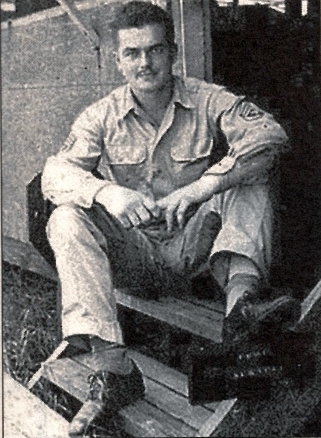Humanity in war: The US combat medic John Warren Smedberg in the Second World War (Published on 18/01/2024)
Just as surely as war gives birth to death and suffering, it also brings about the emergence of people on all sides who have retained their humanity and who provide help and assistance to others in need, even if they have been declared an “enemy” whose support means danger to their own lives.
I. The „Kall bridge Truce“ in November 1944
Doctors and medical staff are called upon by their profession to provide assistance, regardless of which warring party they and the person in need of help belong to. Time and again we read of cases in which doctors, sometimes in cooperation with their enemy counterparts, enforced fighting breaks so that the wounded lying on the battlefield could be helped. One of the best-known cases occurred during the fighting in the Hürtgen Forest with the so-called “Kall bridge Truce” during the All Souls’ Battle at the beginning of November 1944, when a ceasefire was achieved with the help of German doctor Dr Günter Stüttgen so that numerous wounded on both sides could be treated. This event deserves its own consideration and will not be discussed further in this article.
II. Combat medics
First aid on the battlefield is usually provided by medics specially trained for treatment under combat conditions, referred to here as “combat medics”, who are integrated into the fighting units or assigned to them in various ways. Their task is to care for the wounded in the field and treat their injuries. Particularly with regard to the Second World War, there are repeated reports of combat medics who provided help to the wounded, sometimes regardless of their own health, even under the most difficult conditions.
They often did not limit themselves to assisting those on their own side who were in need of help, but also took care of the enemy’s wounded and treated them.
Nevertheless, the names and deeds of these medics, who maintained their humanity even under the most difficult conditions, are often hardly known. There are several books on the US side in which former combat medics describe their experiences.
III. The US combat medic John Warren Smedberg
In one of these books, entitled “Medic! – A WWII Combat Medic Remembers” by Robert L. Smith from 2001, there is a detailed account of one of these special people: Combat medic John Warren Smedberg, who served with the 112th Regiment of the 28th US Infantry Division, inter alia, in the Battle of Hürtgen Forest.
Smith, who himself served as a combat medic with the 28th US Infantry Division during the Second World War, describes Smedberg as follows (“Medic!”, p. 67 ff.):
“The Battle of Hürtgen Forest in November 1944, is rarely mentioned by historians as a questionable action. Many brave men engaged in a continuous series of heroic battles over a ninety-day period. I have known many people who performed heroic acts under special circumstances, but only two stand out as heroes who lived and practiced their beliefs on a daily bases no matter how trying the times. One is a Welshman, a barrister and Professor Emeritus in Criminology from the London School of Economics. He was my mentor during a year’s study there, later becoming my friend. He never wavered in his belief in the sanctity of life even when it meant bucking the wave of patriotism that swept Great Britain in World War II. As a lifelong pacifist and conscientious objector to war he faced ridicule and scorn from friends and colleagues. In lieu of serving in the military, he volunteered to serve with a Quaker Relief organization, driving an ambulance for the British Red Cross and assisting displaced persons at Belsen among other places in Germany.
My second hero is John W Smedberg, a Seventh Day Adventist, who served with me in the 112th Regiment medical detachment and fought in the Hürtgen. I always followed him in roll call. We crossed the Atlantic together, and ended up being assigned to the 28th Division as replacements. Tall and handsome, John could have been sent from Central Casting to portray a vigorous young man from the Minnesota farmlands. He was gentle and kind, non-intrusive in observing his religion, and regularly practiced what he believed no matter where he was. He suffered frequent punishments for refusing to do nonessential work on Saturdays because many of the officers and NCOs failed to understand and make allowances for his day of devotion.
John’s heroics are relative to my story about the battle missed. Much of what I report is drawn from first hand accounts by men of my unit who fought in the Hürtgen Forest for nine days in November, 1944. Some information comes from military archives. By all accounts the battle of the Hürtgen Forest was a horrendous encounter for all those involved.
Following [the fighting in] Wallendorf, the 28th Infantry Division withdrew to defensive positions along the Luxembourg-German border in order to rebuild a badly mauled fighting unit. The division remained in reserve for most of October, making some exploratory attacks along the Siegfried Line. Near the end of the month, orders came down to move into an area known as the Hürtgen, a gloomy expanse of thick woods and treacherous hilly terrain southeast of Aachen, Germany.
(…)
The 28th Infantry Division attacked on November 2 and quickly learned that its mission could not be accomplished. At the first signs of attack, the Germans responded with heavy mortar and artillery fire immediately pinning down the two forward attacking battalions of the 112th Regiment. During the next seven days, the towns of Vossenack and Schmidt were taken and retaken by both warring forces. Positions changed hour by hour and day by day. What was an American line soon became a German line and vice versa. At night troops from both sides would infiltrate enemy positions so that by morning no one was quite sure who was surrounding whom. Hand to hand battles often determined who held what ground for how long and at what costs.
Smedberg was at his best during combat; his dedication to his work made him almost oblivious to the dangers he faced. Brave and heroic while treating the wounded, he frequently was cut off from any medical support and had to set up his own aid station in bunkers, burned out buildings, and shell holes. Treating Germans and Americans alike, he was for many combatants the only source of medical treatment available. By night he would crawl back to the battlefield to treat the wounded, and then gather them for evacuation, or arrange for their return to their own lines. When his own troops were overrun or defeated he remained behind to treat the wounded. He assisted German medics to care for their casualties and insisted that they help him with ours. Time and time again, he returned to rescue American wounded far behind enemy lines. He was recommended for another Silver Star for heroism, the first recommendation having been made at Wallendorf. For a second time, his actions resulted in his again being recommended for a field commission. He accepted the decorations, but refused the commission since it would require that he engage in work that was not permitted on his Sabbath. While he could in good conscience tend to the wounded anytime, he could not put himself in the position of ordering others to do things that would be inappropriate to his religious beliefs. We all respected the sincerity of his beliefs, especially the dozens of men he saved during that long week in the Hürtgen.”
John Warren Smedberg was born on 16/09/1921 in College Place, Washington/USA. He served from 16/08/1943 to 20/10/1945 as a combat medic in the 112th Regiment of the 28th US Infantry Division and was awarded the Silver Star, the Bronze Star and the Purple Heart. He died on 06/03/2008 in Bemidji, Beltrami County, and was buried in the Guthrie Cemetery, Hubbard Country, Minnesota/USA.
(Head picture: Memorial near the former Raffelsbrand forester’s lodge,
which was heavily contested in January 1945, October 2023)
If you wish to support my work, you can do so here. Many thanks!


